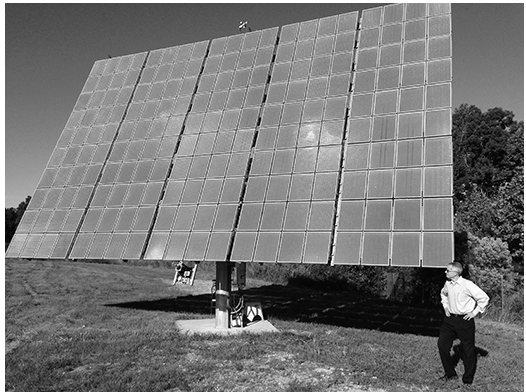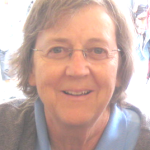
THE NEW SEMPRIUS solar power unit will reportedly produce power at less than 5 cents per kilowatt hour. semprius.com
 The first article examined the status of a startup called Semprius that says its next generation of a power unit will produce electricity at less than 5 cents per kilowatt hour — cheaper than a new natural gas plant. The power unit is the size of a movie theater screen, has a tracking mechanism that continuously points at the sun and has over 100,000 small lenses and smaller solar cells. Their use of smaller solar cells and lenses is itself exciting, but most exciting is the possibility that this company could break the U.S. Energy Information Administration’s estimate of price competitiveness for solar. Currently the EIA’s estimate is that a new solar plant will produce power at just under 15 cents per kilowatt hour, which is not competitive with the 6.5-cent cost for natural gas power. If Semprius can produce at 5 cents per kilowatt hour, then solar can deliver energy competitively.
The first article examined the status of a startup called Semprius that says its next generation of a power unit will produce electricity at less than 5 cents per kilowatt hour — cheaper than a new natural gas plant. The power unit is the size of a movie theater screen, has a tracking mechanism that continuously points at the sun and has over 100,000 small lenses and smaller solar cells. Their use of smaller solar cells and lenses is itself exciting, but most exciting is the possibility that this company could break the U.S. Energy Information Administration’s estimate of price competitiveness for solar. Currently the EIA’s estimate is that a new solar plant will produce power at just under 15 cents per kilowatt hour, which is not competitive with the 6.5-cent cost for natural gas power. If Semprius can produce at 5 cents per kilowatt hour, then solar can deliver energy competitively.
Naturally, there are challenges, and that includes funding their next phase. We’ll have to see if the company’s leadership can secure the financial backing to move forward.
On the home front
Meanwhile, residential solar panels continue to become more efficient. Having a 20-percent efficiency rate of converting sunlight to electricity from a panel was excellent output even a year ago. Today companies like Panasonic are producing solar cells with a nearly 26-percent efficiency. And the Department of Energy is working on a project called “SunShot” that “seeks to make solar energy cost-competitive with other forms of electricity by the end of the decade.”
It’s interesting to connect the dots from Semprius to the DOE’s goal, which is to “drive down the installed cost of solar,” saying, “When the price of solar electricity reaches about $0.06 per kilowatt hour over its lifetime, it will be cost-competitive with other, non-renewable forms of electricity. This in turn will enable solar-generated power to grow from less than .05 percent of the current electricity supply to roughly 14 percent by 2030, and to 27 percent by 2050 . . . ” Come on, Semprius!
I’ve noticed brochures have appeared in Benicia’s Planning Department office that provide information for contractors on the upcoming HERO (Home Energy Renovation Opportunity) program that includes solar panels among many home efficiency improvements. I’m hoping that the HERO and PACE (Property Assessed Clean Energy) programs will generate great business opportunities for our local contractors and energy and money savings for our residents and commercial owners. If you’re thinking about home renovations, check out the programs that are available to you.
Igniting the spark of creativity
What seems, after the fact, to be so obvious to us — for example, having solar photovoltaic cells capture sunlight and convert it to electricity — takes a leap of creativity. If we follow the solar industry at all, it seems that the creative innovators were constantly being downplayed as impractical and pursuing a folly. Yet that spark of creativity was never extinguished, and now the industry is poised to make significant contributions to how we live.
The second article in Technology Review that caught my eye was a reprint of an essay by Isaac Asimov. I think it’s good to remember what ignites creativity and how we might help kindle that flame once lit.
Asimov was an American author and professor of biochemistry at Boston University. He is best known for his science fiction work. He had been asked in 1950 to consult with a firm that was working on an anti-missile project but declined “because he did not want to have access to any secret classified information as it would limit his freedom of expression.” Instead, he wrote an essay for them that asked, “How do people get new ideas?”
In essence, Asimov felt that creativity required people with good backgrounds in a particular field “but also people capable of making a connection between item 1 and item 2 which might not ordinarily seem connected.” He gave the example of Charles Darwin and Alfred Wallace, both of whom developed the theory of natural selection. He said they both traveled to distant places and observed strange species of plants and animals. He said the catalyst for their thinking was Malthus’s “Essay on Population.” Their genius was in making the leap from Malthus’ thinking about people to species in general.
Asimov said that making this cross-connection of ideas takes a self-assured person who is “willing to fly in the face of reason, authority, and common sense. . . .” The other ingredient for creativity, he said, is isolation, or an environment in which the creative person is “continually working at it.” Add to this an atmosphere of “ease, relaxation and a general sense of permissiveness . . .” as “. . . the world in general disapproves of creativity, and to be creative in public is particularly bad.”
Benicia is a community enriched and broadened by our artists, so I hope we can embrace and sustain creativity on all fronts. My favorite poet, Emily Dickinson, had a beautiful line that celebrates this: “I dwell in Possibility, a fairer House than Prose . . . .”
Learn more
• Energy.gov/eere/sunshot/about — This also has a good video on the Sunshot initiative
• Sustainablebenicia.org — sustainablebenicia.org/residents
Constance Beutel is the chair of Benicia’s Community Sustainability Commission. She is a university professor and videographer and holds a doctorate from the University of San Francisco.






That array is a thing of beauty.